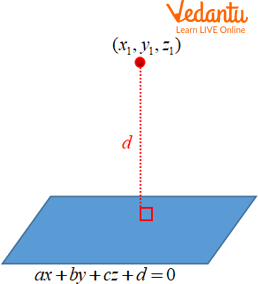
The points A(−1, 3, 0), B(2, 2, 1) and C(1, 1, 3) determine a plane. Find the distance from the plane to the point D(5, 7, 8).
a) \[\sqrt {66} \]
b) \[\sqrt {71} \]
c) \[\sqrt {73} \]
d) \[\sqrt {76} \]
Answer
216.6k+ views
Hint: First find the Cartesian equation of the plane using the three points and then find the perpendicular distance between the plane and the point D.
Formula Used:Cartesian equation of the plane passing through three points \[\left( {{x_1},{y_1},{z_1}} \right),\left( {{x_2},{y_2},{z_2}} \right)\,{\rm{and}}\left( {{x_3},{y_3},{z_3}} \right)\] is
\[\left| {\begin{array}{*{20}{c}}{x - {x_1}}&{y - {y_1}}&{z - {z_1}}\\{{x_2} - {x_1}}&{{y_2} - {y_1}}&{{z_2} - {z_1}}\\{{x_3} - {x_1}}&{{y_3} - {y_1}}&{{z_3} - {z_1}}\end{array}} \right| = 0\]

The perpendicular distance of the point \(({x_1},{y_1},{z_1})\)from the plane \(ax + by + cz + d = 0\)is \(d = \left| {\dfrac{{a{x_1} + b{y_1} + c{z_1} + d}}{{\sqrt {{a^2} + {b^2} + {c^2}} }}} \right|\)
Complete step by step solution:Cartesian equation of the plane passing through three points A(−1,3,0),
B(2, 2, 1) and C(1,1, 3) is
\[\left| {\begin{array}{*{20}{c}}{x - {x_1}}&{y - {y_1}}&{z - {z_1}}\\{{x_2} - {x_1}}&{{y_2} - {y_1}}&{{z_2} - {z_1}}\\{{x_3} - {x_1}}&{{y_3} - {y_1}}&{{z_3} - {z_1}}\end{array}} \right| = 0\]
Here, A(−1,3,0) = \[\left( {{x_1},{y_1},{z_1}} \right)\], B(2, 2, 1) = \[\left( {{x_2},{y_2},{z_2}} \right)\] and C(1, 1, 3) = \[\left( {{x_3},{y_3},{z_3}} \right)\]
\[\left| {\begin{array}{*{20}{c}}{x + 1}&{y - 3}&{z - 0}\\{2 + 1}&{2 - 3}&{1 - 0}\\{1 + 1}&{1 - 3}&{3 - 0}\end{array}} \right| = 0\]
\[\left| {\begin{array}{*{20}{c}}{x + 1}&{y - 3}&z\\3&{ - 1}&1\\2&{ - 2}&3\end{array}} \right| = 0\]
\[(x + 1)( - 3 + 2) - (y - 3)(9 - 2) + z( - 6 + 2) = 0\]
\[(x + 1)( - 1) - (y - 3)(7) + z( - 4) = 0\]
\[ - x - 1 - 7y + 21 - 4z = 0\]
\[x + 7y + 4z - 20 = 0\]
Perpendicular distance of the point D(5, 7, 8) from the plane\[x + 7y + 4z - 20 = 0\]
\( = \left| {\dfrac{{(1)(5) + (7)(7) + (4)(8) - 20}}{{\sqrt {{1^2} + {7^2} + {4^2}} }}} \right|\)
\( = \left| {\dfrac{{5 + 49 + 32 - 20}}{{\sqrt {1 + 49 + 16} }}} \right|\)
\( = \left| {\dfrac{{66}}{{\sqrt {66} }}} \right|\)
\( = \sqrt {66} \)
Option ‘A’ is correct
Note: The student may make a mistake in the expansion of the determinant. The student may have used the incorrect formula for calculating the perpendicular distance from a point to the plane as the perpendicular distance from the origin to the plane.
Formula Used:Cartesian equation of the plane passing through three points \[\left( {{x_1},{y_1},{z_1}} \right),\left( {{x_2},{y_2},{z_2}} \right)\,{\rm{and}}\left( {{x_3},{y_3},{z_3}} \right)\] is
\[\left| {\begin{array}{*{20}{c}}{x - {x_1}}&{y - {y_1}}&{z - {z_1}}\\{{x_2} - {x_1}}&{{y_2} - {y_1}}&{{z_2} - {z_1}}\\{{x_3} - {x_1}}&{{y_3} - {y_1}}&{{z_3} - {z_1}}\end{array}} \right| = 0\]

The perpendicular distance of the point \(({x_1},{y_1},{z_1})\)from the plane \(ax + by + cz + d = 0\)is \(d = \left| {\dfrac{{a{x_1} + b{y_1} + c{z_1} + d}}{{\sqrt {{a^2} + {b^2} + {c^2}} }}} \right|\)
Complete step by step solution:Cartesian equation of the plane passing through three points A(−1,3,0),
B(2, 2, 1) and C(1,1, 3) is
\[\left| {\begin{array}{*{20}{c}}{x - {x_1}}&{y - {y_1}}&{z - {z_1}}\\{{x_2} - {x_1}}&{{y_2} - {y_1}}&{{z_2} - {z_1}}\\{{x_3} - {x_1}}&{{y_3} - {y_1}}&{{z_3} - {z_1}}\end{array}} \right| = 0\]
Here, A(−1,3,0) = \[\left( {{x_1},{y_1},{z_1}} \right)\], B(2, 2, 1) = \[\left( {{x_2},{y_2},{z_2}} \right)\] and C(1, 1, 3) = \[\left( {{x_3},{y_3},{z_3}} \right)\]
\[\left| {\begin{array}{*{20}{c}}{x + 1}&{y - 3}&{z - 0}\\{2 + 1}&{2 - 3}&{1 - 0}\\{1 + 1}&{1 - 3}&{3 - 0}\end{array}} \right| = 0\]
\[\left| {\begin{array}{*{20}{c}}{x + 1}&{y - 3}&z\\3&{ - 1}&1\\2&{ - 2}&3\end{array}} \right| = 0\]
\[(x + 1)( - 3 + 2) - (y - 3)(9 - 2) + z( - 6 + 2) = 0\]
\[(x + 1)( - 1) - (y - 3)(7) + z( - 4) = 0\]
\[ - x - 1 - 7y + 21 - 4z = 0\]
\[x + 7y + 4z - 20 = 0\]
Perpendicular distance of the point D(5, 7, 8) from the plane\[x + 7y + 4z - 20 = 0\]
\( = \left| {\dfrac{{(1)(5) + (7)(7) + (4)(8) - 20}}{{\sqrt {{1^2} + {7^2} + {4^2}} }}} \right|\)
\( = \left| {\dfrac{{5 + 49 + 32 - 20}}{{\sqrt {1 + 49 + 16} }}} \right|\)
\( = \left| {\dfrac{{66}}{{\sqrt {66} }}} \right|\)
\( = \sqrt {66} \)
Option ‘A’ is correct
Note: The student may make a mistake in the expansion of the determinant. The student may have used the incorrect formula for calculating the perpendicular distance from a point to the plane as the perpendicular distance from the origin to the plane.
Recently Updated Pages
JEE Atomic Structure and Chemical Bonding important Concepts and Tips

JEE Amino Acids and Peptides Important Concepts and Tips for Exam Preparation

Electricity and Magnetism Explained: Key Concepts & Applications

Chemical Properties of Hydrogen - Important Concepts for JEE Exam Preparation

JEE Energetics Important Concepts and Tips for Exam Preparation

JEE Isolation, Preparation and Properties of Non-metals Important Concepts and Tips for Exam Preparation

Trending doubts
JEE Main 2026: Application Form Open, Exam Dates, Syllabus, Eligibility & Question Papers

Derivation of Equation of Trajectory Explained for Students

Hybridisation in Chemistry – Concept, Types & Applications

Understanding the Angle of Deviation in a Prism

Understanding Collisions: Types and Examples for Students

How to Convert a Galvanometer into an Ammeter or Voltmeter

Other Pages
JEE Advanced Marks vs Ranks 2025: Understanding Category-wise Qualifying Marks and Previous Year Cut-offs

Understanding Atomic Structure for Beginners

Ideal and Non-Ideal Solutions Explained for Class 12 Chemistry

Degree of Dissociation: Meaning, Formula, Calculation & Uses

Understanding Electromagnetic Waves and Their Importance

Understanding the Electric Field of a Uniformly Charged Ring




